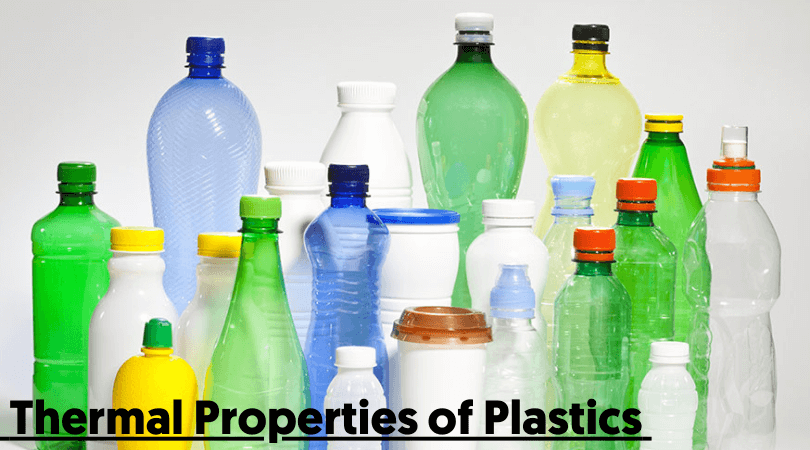What are the Thermal Properties of Plastics?
Thermal properties in plastics mean their response to temperature changes and how they react when applied to heat. As a solid material absorbs heat, its temperature rises with a slight increase in dimensions.
There are generally 4 thermal properties in plastic materials – heat deflection temperature, glass transition temperature, Continuous Service Temperature, and Coefficient of Thermal Expansion.
Here is a table explaining the plastic thermal properties.
| Materials | Max Continus Servoce temprature in air | Heat Deflection Temperature |
Coefficient of Linear Thermal Expansion
|
| °F, 264/psi | |||
| ASTM Test | °F | D648 |
in/in/°F x 10-5, D696
|
| ABS (Acrylonitrile-Butadiene-Styrene) | 160 | 177 | 5.6 |
| Acetal | 212 | 257 | 6.8 |
| Acrylic | 160 | 195 | 4 |
| CAB | – | 181 | – |
| ECTFE (Ethylene Chlorotrifluoroethylene) | 302 | 160 | 5 |
| ETFE (Ethylene Tetrafluoroethylene) | 311 | – | 7.4 |
| HDPE | 170 | – | 9 |
| High Impact Polystyrene | – | 169 | 4.5 |
| LDPE | – | – | – |
| Nylon | 210 | 194 | 4.5 |
| PAI (Polyamide-imide) | 500` | 532 | 1.7 |
| PBT | 245 | 130 | – |
| PEEK | 480 | 306 | 2.6 |
| PET | 230 | 175 | 3.9 |
| PETG | – | 157 | 3.8 |
| Polycarbonate | 240 | 270 | 3.8 |
| Polypropylene | 180 | – | 5 |
| PTFE | 500 | – | 8.9 |
| PVC | 140 | 158 | 3.2 |
| PVDF | 302 | 235 | 7.1 |
| TPE | – | – | – |
| UHMW | 180 | – | 11.1 |
| Ultem® | 338 | 392 | 3.1 |
Plastic Thermal Properties

- Glass Transition Temprature
- Continues Service Temprature
- Heat Deflection Temperature
- Coefficient of Linear Thermal Expansion
Glass Transition Temprature
When an amorphous material is heated, the temperature at which the material transforms into a viscous liquid is called the glass transition temperature.
Crystalline Polymers
Crystalline materials don’t have a specific glass transition temperature. Instead, they have a melting point. Their melting point is a temperature where an ordered molecular structure becomes disordered liquid.
Crystalline materials have a highly rated and defined molecular structure.
It includes materials like PEEK, PPS, PFA, etc. These polymers have regular chain structures and are more likely to form crystalline regions.
More crystallinity means more strength and less flexibility for the materials. High crystallinity also means that less light will pass through these materials.
Crystallinity will provide benefits like chemical resistance, strength, stability, and stiffness.
Amorphous Polymers
Amorphous polymers are also known for not having a melting point but a glass transition temperature. These polymers soften upon heating over a wide range of temperatures. Their molecular structure comprises unsynchronized molecular chains not arranged in ordered crystals.; however, they have scattered around even though they are not solid-state.
Semi-crystalline Polymers
There are polymers with a partially crystalline structure, with the crystalline regions spread within the amorphous material. The crystalline molecules have a melting point, and the amorphous molecules have a glass transition temperature.
Interesting Read – How is Plastic Made? A Simple and Detailed Explanation.
Continues Service Temprature
Continuous service temperature is when a material can perform assuredly in a long-term application. Over the temperature limit, the mechanical and electrical properties of the material will start degrading over time.
The crucial factors affecting the continuous service temperature of many materials are – time and loading levels and additives and reinforcements used in the formations.
The most common method for comparing different materials in terms of continuous service temperatures is the Underwriter Laboratory (UL) Relative Thermal Index or RTI.
The process of RTI is utilized to figure out the loss of properties of plastic versus time. Generally speaking, when plastic exhibits maximum continuous temperature – robust and long-term performance is observed.
In a nutshell, continuous service temperature backs up the materials’ integrity for their intended application period.
Let’s see the use of continuous service temperature in commonly used polymers:
Amorphous Polymers
| Material | Max. Value (°C) | Min. Value (°C) |
Glass transition temp. (°C)
|
| PC | 140 | 100 | 147 |
| PEI | 170 | 170 | 217 |
| PMMA | 90 | 70 | 105 |
| PESU | 185 | 175 | 230 |
| PSU | 180 | 150 | 190 |
The table above shows continuous temperatures’ maximum and minimum values and glass transition temperatures.
The glass transition temperature is directly proportional to the continuous use temperature for all the above amorphous polymers. A significant change in the mechanical and electrical properties of the polymer at Tg can be seen.
Semi-crystalline Polymers
| Material | Max. Value (°C) | Min. Value (°C) |
Glass transition temp. (°C)
|
| PEEK | 260 | 154 | 143 |
| PET | 140 | 80 | 69 |
| PPS | 220 | 200 | 126 |
| PBT | 140 | 80 | 40 |
| PA6 | 120 | 80 | 50 |
The above table shows that the continuous service temperatures for all the polymers are more than the Tg value.
Heat Deflaction Temprature
Heat deflection temperature or heat distortion temperature is a way to measure the polymer’s resistance or withstanding capacity towards distortion at a given temperature.
It can be any particular temperature at which the test bar will be warped by 0.35 mm under a given load (0.35 is a random value and has no significance).
The factors making HDT significant are
- Used in many characteristics products design and manufacturing of parts using thermoplastic components.
- Provides a value to be compared within different materials
- The greater the heat deflection, the higher the chances of a faster molding process in the injection molding method.
Engaging Read – Mechanical Properties of Plastic Materials | The Definitive Guide
Coefficient of Linear Thermal Expansion
The coefficient of linear thermal expansion is a polymer attribute that comprises the ability of a plastic to expand under temperature elevation. It shows us the dimensional stability of a developed part under temperature variation.
The linear coefficiency is measured using the following formula:
α = ΔL / (L0 * ΔT)
Thermal expansion and differences can be detrimental and develop internal stresses and unusual warping in the material, which can hurt the integrity of the final part, thus making CLTE crucial for the unit economies of production and the functioning and aesthetics of the product. Below are some applications:
- It assists in determining the dimensional characteristics of parts subject to temperature changes.
- It helps maintain a product’s aesthetic by predicting shrinkage in injection molded components.
- It also comes in handy for predicting the thermal stresses that can occur while bonding plastic material with metals.
Below is the table with CLTE value for all mainstream plastics
| Material | Max. Value (10-5 /°C) |
Min. value (10-5 /°C)
|
| ABS | 15 | 7 |
| CA | 18 | 8 |
| CAB | 17 | 10 |
| ECTFE | 9 | 6 |
| EVA | 20 | 16 |
| HDPE | 11 | 6 |
| HIPS | 20 | 5 |
| LDPE | 20 | 10 |
| PA 6 | 12 | 5 |
| PBT | 10 | 6 |
| PC | 4 | 2 |
| PE | 5 | 5 |
| PEEK | 10.8 | 4.7 |
| PEI | 6 | 5 |
| PET | 8 | 6 |
| PETG | 8 | 8 |
| PMMA | 9 | 5 |
| PP | 17 | 7 |
| PS – Crystal | 8 | 5 |
| PTFE | 20 | 7 |
| PVC | 4 | 2 |
| UHMWPE | 20 | 13 |
| XLPE | 10 | 10 |
All the values shown in all the tables in the post are derived after extensive research, but they are for information purposes only. Do consult your manufacturer for accurate values.
Suggested Read –
- What is Compressive Strength of Plastics | The Complete Guide
- Physical Properties of Plastic Materials | The Complete Guide
- What is Hardness in Plastics? An In-Depth Guide
- What is Shore Hardness Scale? | The Complete Guide
- What is Processing and Drying Temperatures of Plastics
FAQs
Below are the frequently asked questions on thermal plastics. Let’s dig deep to know more.
Is plastic a good thermal insulator?
Plastics possess outstanding insulating properties, allowing them to effectively retain heat – a feature that can benefit objects like a coffee cup sleeve.
What plastic is the best thermal insulator?
Polybenzimidazole (PBI) is the leading engineering thermoplastic with exceptional heat and wear resistance, strength, and mechanical property stability. PBI fibers are also noteworthy for their lack of a known melting point, non-flammable nature, and inability to adhere to other plastics.
Does plastic hold heat better than metal?
Metals typically have high thermal conductivity and are more responsive to temperature changes in their environment than plastics or foams. In contrast, plastics are considered insulators and respond very slowly to changes in the surrounding temperature.
Final Words
To sum up, comprehending plastic thermal properties is vital to their successful implementation in various industries. These materials can display diverse thermal behaviors, such as thermal conductivity, specific heat, and coefficient of thermal expansion, which are shaped by factors like their chemical composition, structure, and processing techniques.
Precisely anticipating and controlling these thermal properties is indispensable to guaranteeing plastic products’ optimal functionality and robustness.
Thanks to continuous research and progress in plastic technology, we can look forward to observing even more ingenious uses for these multipurpose materials. Nonetheless, it is also critical to acknowledge plastic manufacturing and disposal’s ecological impact and strive for more sustainable substitutes.
I hope you like my article. Kindly comment your reviews in the comment box
Have a wonderful day.
Quick Navigation


Dear Ladies and Gentleman,
we would be interested to know the evaporation enthalpy of PEEK – but we face difficulty to find it on the web. Can you help us with this quest?
Kind Regards
Micha